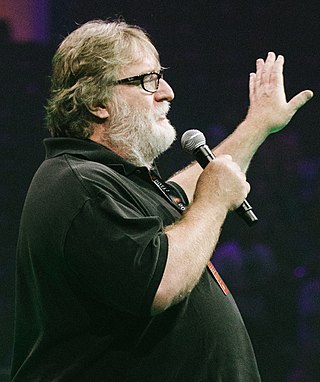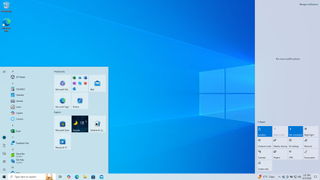
Microsoft Corporation is an American multinational corporation and technology company headquartered in Redmond, Washington. Microsoft's best-known software products are the Windows line of operating systems, the Microsoft 365 suite of productivity applications, and the Edge web browser. Its flagship hardware products are the Xbox video game consoles and the Microsoft Surface lineup of touchscreen personal computers. Microsoft ranked No. 14 in the 2022 Fortune 500 rankings of the largest United States corporations by total revenue; and it was the world's largest software maker by revenue in 2022 according to Forbes Global 2000. It is considered one of the Big Five American information technology companies, alongside Alphabet, Amazon, Apple, and Meta.
Matroska is a project to create a container format that can hold an unlimited number of video, audio, picture, or subtitle tracks in one file. The Matroska Multimedia Container is similar in concept to other containers like AVI, MP4, or Advanced Systems Format (ASF), but is an open standard.

Akamai Technologies, Inc. is an American delivery company that provides content delivery network (CDN), cybersecurity, DDoS mitigation, and cloud services. Headquartered in Cambridge, Massachusetts, it operates a worldwide network of servers whose capacity it rents to customers running websites and other web services.
Criticism of Microsoft has followed various aspects of its products and business practices. Issues with ease of use, robustness, and security of the company's software are common targets for critics. In the 2000s, a number of malware mishaps targeted security flaws in Windows and other products. Microsoft was also accused of locking vendors and consumers in to their products, and of not following or complying with existing standards in its software. Total cost of ownership comparisons between Linux and Microsoft Windows are a continuous point of debate.

Gabe Logan Newell, also known by his nickname Gaben, is an American businessman who is the president and co-founder of the video game company Valve Corporation.

Windows Error Reporting (WER) is a crash reporting technology introduced by Microsoft with Windows XP and included in later Windows versions and Windows Mobile 5.0 and 6.0. Not to be confused with the Dr. Watson debugging tool which left the memory dump on the user's local machine, Windows Error Reporting collects and offers to send post-error debug information using the Internet to Microsoft when an application crashes or stops responding on a user's desktop. No data is sent without the user's consent. When a crash dump reaches the Microsoft server, it is analyzed, and information about a solution is sent back to the user if available. Solutions are served using Windows Error Reporting Responses. Windows Error Reporting runs as a Windows service. Kinshuman Kinshumann is the original architect of WER. WER was also included in the Association for Computing Machinery (ACM) hall of fame for its impact on the computing industry.

Microsoft Silverlight is a discontinued application framework designed for writing and running rich internet applications, similar to Adobe's runtime, Adobe Flash. While early versions of Silverlight focused on streaming media, later versions supported multimedia, graphics, and animation, and gave support to developers for CLI languages and development tools. Silverlight was one of the two application development platforms for Windows Phone, but web pages using Silverlight did not run on the Windows Phone or Windows Mobile versions of Internet Explorer, as there was no Silverlight plugin for Internet Explorer on those platforms.
An open API is a publicly available application programming interface that provides developers with programmatic access to a software application or web service. Open APIs are APIs that are published on the internet and are free to access by consumers.

Visual Studio is an integrated development environment (IDE) developed by Microsoft. It is used to develop computer programs including websites, web apps, web services and mobile apps. Visual Studio uses Microsoft software development platforms including Windows API, Windows Forms, Windows Presentation Foundation (WPF), Windows Store and Microsoft Silverlight. It can produce both native code and managed code.

The blue screen of death is a critical error screen displayed by the Microsoft Windows and ReactOS operating systems in the event of a fatal system error. It indicates a system crash, in which the operating system has reached a critical condition where it can no longer operate safely.
In engineering, debugging is the process of finding the root cause of and workarounds and possible fixes for bugs.

Joe Belfiore is an American business executive who has held various roles at Microsoft since August 1990, mostly in the field of user experience. A frequent speaker, Belfiore has appeared at many Microsoft conferences, often giving demos on stage and/or acting as a spokesperson for the company. In 2018, he was named the #1 Microsoft Influencer for fans to follow on Twitter. In 2004, he gave a TED Talk in-person at the TED Conference in Monterey,CA. In summer 2023 he retired from Microsoft and is now active as chair of a non-profit board.
In computer programming, the Arm Image Format (AIF) is an object file format used primarily for software intended to run on ARM microprocessors. It was introduced by Acorn Computers for use with their Archimedes computer. It can optionally facilitate debugging, including under operating systems running on other processor architectures.

Windows 10 is a major release of Microsoft's Windows NT operating system. It is the direct successor to Windows 8.1, which was released nearly two years earlier. It was released to manufacturing on July 15, 2015, and later to retail on July 29, 2015. Windows 10 was made available for download via MSDN and TechNet, as a free upgrade for retail copies of Windows 8 and Windows 8.1 users via the Microsoft Store, and to Windows 7 users via Windows Update. Windows 10 receives new builds on an ongoing basis, which are available at no additional cost to users, in addition to additional test builds of Windows 10, which are available to Windows Insiders. Devices in enterprise environments can receive these updates at a slower pace, or use long-term support milestones that only receive critical updates, such as security patches, over their ten-year lifespan of extended support. In June 2021, Microsoft announced that support for Windows 10 editions which are not in the Long-Term Servicing Channel (LTSC) will end on October 14, 2025.
Windows Insider is an open software testing program by Microsoft that allows users globally who own a valid license of Windows 11, Windows 10, or Windows Server to register for pre-release builds of the operating system previously only accessible to software developers.

Visual Studio Code, also commonly referred to as VS Code, is a source-code editor developed by Microsoft for Windows, Linux, macOS and web browsers. Features include support for debugging, syntax highlighting, intelligent code completion, snippets, code refactoring, and embedded version control with Git. Users can change the theme, keyboard shortcuts, preferences, and install extensions that add functionality.

Dona Sarkar is a software engineer, author, public speaker and the owner of a fashion business.
Windows 10 Mobile is a discontinued mobile operating system developed by Microsoft. It was released to manufacturing on November 20, 2015, and was made generally available on March 17, 2016. In October 2017, Microsoft announced that it would pause the active development of Windows 10 Mobile, and future development will be limited to maintenance releases and security patches. The last feature update is the Fall Creators Update. The last version of Windows 10 Mobile reached the end of life on January 14, 2020. Development for Windows 10 Mobile has completely ceased since then.
Microsoft, a technology company historically known for its opposition to the open source software paradigm, turned to embrace the approach in the 2010s. From the 1970s through 2000s under CEOs Bill Gates and Steve Ballmer, Microsoft viewed the community creation and sharing of communal code, later to be known as free and open source software, as a threat to its business, and both executives spoke negatively against it. In the 2010s, as the industry turned towards cloud, embedded, and mobile computing—technologies powered by open source advances—CEO Satya Nadella led Microsoft towards open source adoption although Microsoft's traditional Windows business continued to grow throughout this period generating revenues of 26.8 billion in the third quarter of 2018, while Microsoft's Azure cloud revenues nearly doubled.
The original version of Windows 10 was released in July 2015. It carries the build number 10.0.10240; while Microsoft has stated that there was no designated release to manufacturing (RTM) build of Windows 10, build 10240 was described as an RTM build by various media outlets. It was retroactively named "version 1507" by Microsoft per its naming conventions that have the last 2 digits of the year and the month number for future stable releases of the operating system.










